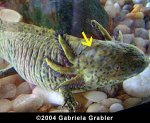My "blue" melanoid came down with these spots on her body a few days ago, but I was having issues with my camera and couldn't take pics until today. These past few days, she's been in the fridge with methylene blue, and I only notice a slight improvement.
In addition to having these spots, her gills also look a bit shabby, as you can see below.
She shared her tank with a leucistic (who has since been moved out of the tank) and the leucistic does not have these spots and shows absolutely no signs of ill health.
Please tell me what these spots are and how I can treat them- they look painful. Is it ich?:






http://www.rebeldolly.com/ich1.jpg
In addition to having these spots, her gills also look a bit shabby, as you can see below.
She shared her tank with a leucistic (who has since been moved out of the tank) and the leucistic does not have these spots and shows absolutely no signs of ill health.
Please tell me what these spots are and how I can treat them- they look painful. Is it ich?:






http://www.rebeldolly.com/ich1.jpg

